

On the TV program "Pompeii" Professor Mary Beard was shown items others are not allowed to see and she slipped on a gold bracelet last worn 2000 years ago. It had been worn by one of around fifty people whose skeletons were found in a cellar in Oplontis.
The skeletons were segregated into two groups: the rich and the others. The former had many green bones, the result of acidic soil on metal jewellery, belts etc. The poor ones had no belongings.
One woman had two bags of coins: silver ones that showed signs of wear and gold ones that were "perfect."
A young woman was found to have been 8 1/2 months pregnant and they thought this might have been the reason the group did not flee as others did.
There were also young twins who must have been dreadfully sick but who seemed to have received excellent care. They were found amongst the poorer members of the group.
See and hear more at http://www.bbc.co.uk/news/world-europe-11952322.
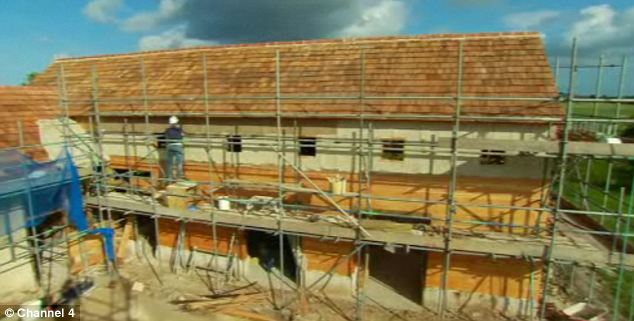
Read the article, "A very grand design: New Channel 4 series challenges builders to construct a huge Roman villa using only ancient methods, by Catherine Ead. Don't forget to take the Virtual Tour.
For 70 years, archaeologists have tried to unravel the secrets of one of the most remarkable Roman villas discovered in Britain.
The Lullingstone villa was uncovered in 1939 when a tree was blown down by high winds. Over the years, archaeologists found one of the first Christian chapels in Britain, the graves of a man and a woman, a pair of unique floor mosaics and two marble busts.
The owner of the villa in Kent has finally been identified as a former Emperor of Rome. Read more.
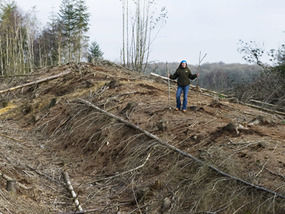
A vast stretch of one of Britain's first Roman roads has been uncovered in the depths of a forest. Read more
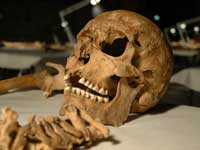 In a recent "Secrets of the Dead" on PBS, archaeologists in York uncovered forty-four bodies that had been decapitated and generally brutalized. DNA tests showed that they were from all over the Empire (rather than Caledonian warriors, which had been one possibility). Cups in the cemetery dated the burials to the time right around 200 AD.
In a recent "Secrets of the Dead" on PBS, archaeologists in York uncovered forty-four bodies that had been decapitated and generally brutalized. DNA tests showed that they were from all over the Empire (rather than Caledonian warriors, which had been one possibility). Cups in the cemetery dated the burials to the time right around 200 AD.
Between the archaeologists, Cassius Dio and modern historians, they finally concluded that these were the people Caracalla murdered after the death of Severus--his old tutor who was trying to talk him into getting along with his brother, the doctors who had refused to hasten Severus's death, assorted people who had prevented him from killing his father, and anybody he wanted to get rid of before returning to Rome to kill his brother.
Not often that archaeology and history mesh so neatly! The full show doesn't seem to be available online, but there's a description at http://www.pbs.org/wnet/secrets/previous_seasons/case_headless/index.html.
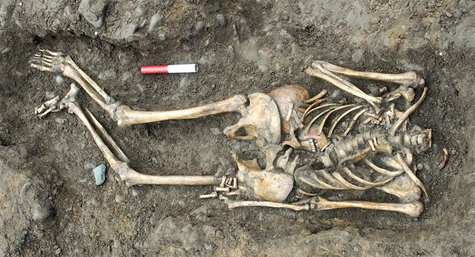
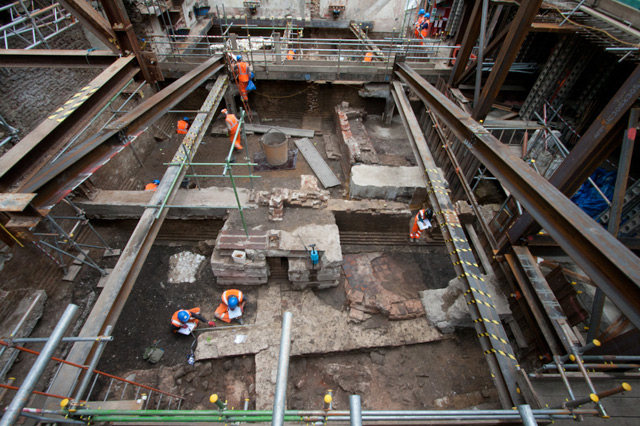
Railway engineers working on the Thameslink programme at London Bridge have unearthed the remains of a Roman bath that once stood on the site.
Learn more at http://londonist.com/2011/09/remains-of-roman-bath-found-in-borough.php. Also here's a very interesting and colorful site: Explore Roman London with new APP.
Two significant Roman artifacts have been unearthed in the ancient city of Apollonia, archaeologists have announced.
Read all about it at http://www.balkaninsight.com/en/article/archaeologists-hail-roman-discoveries-in-apollonia.
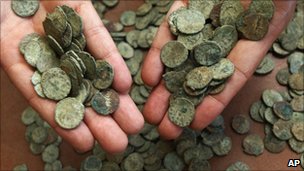
About 53,000 coins were found buried in a field near Frome in Somerset
The largest ever collection of Roman coins found in Britain in one pot will stay in the county where it was unearthed.
Read more.
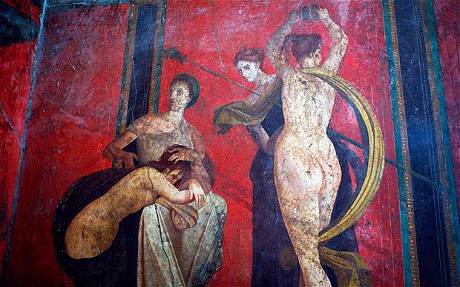
The brilliant hue featured in Pompeiian frescoes may originally have been yellow.
"Pompeiian red" frescoes in the town were only turned red by the gases emitted from Vesuvius as it erupted in AD79. Read the article in The Telegraph.
 Three of the four top girls' names have Latin origins - Olivia (from Latin 'Oliva' meaning Olive), Emily (from the Latin 'Aemilianus', a Latin family name) and Grace (from Latin 'Gratia', meaning goodwill or kindness).
Three of the four top girls' names have Latin origins - Olivia (from Latin 'Oliva' meaning Olive), Emily (from the Latin 'Aemilianus', a Latin family name) and Grace (from Latin 'Gratia', meaning goodwill or kindness).
Anno Domini shortened to AD translated from the Latin for "the year of our Lord" counts the years after the birth of Christ,
Before Christ, or BC, refers to the years before this time.
Introduced in the sixth century by Dionysius Exiguus the terms are used in the Gregorian calendar, the Christian calendar recognised world-wide.
Common Era or CE and Before Common Era, BCE have since the 19th Century been in use to non-Christians as neutral alternatives.
In April 2010 the plaster-coated remains of some of the Pompeii victims went on display.
Read more about this fascinating display at http://news.bbc.co.uk/1/hi/world/europe/8604198.stm.
Speculative Fiction also known as Uchrony refers to an alternative Earth where one or more historical events vary from the way they unfolded in the real world., for example, a world where the Romans never left Britain.
Quote: Last week, Reddit - user "The_Quiet_Earth," asked, "Could I destroy the entire Roman Empire during the reign of Augustus if I travelled back in time with a modern U.S. Marine infantry battalion or MEU?"
In response,James Erwin began writing "Rome Sweet Rome", which literally tells the story of an Afghanistan-bound MEU (Marine Expeditionary Unit) that is inexplicably transported through time to Rome in the year 23 BC.
Read all about it at http://screenrant.com/james-erwin-rome-sweet-rome-interview-movie-reddit-robf-131012/
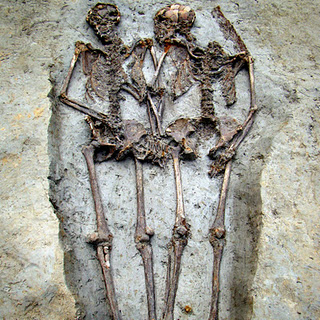
See http://news.discovery.com/history/skeletons-lovers-ancient-italy-111021.html.
Rethinking the fall of Rome's republic
Historian's innovative hypothesis paints new picture of ancient Italy and aims to explain how the Roman Republic fell.
Peter Dizikes, MIT News Office
Read all about it at http://web.mit.edu/newsoffice/2011/profile-broadhead-1109.html
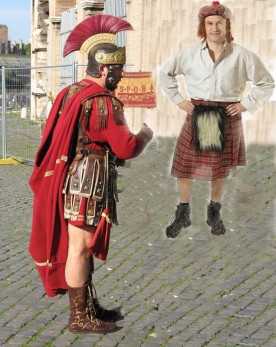
"An archaeologist works on a mosaic discovered in downtown Rome, Friday, July 29, 2011. Excavations in the bowels of an ancient Roman hill have turned up a well-preserved, late 1st Century wall mosaic with a figure of Apollo, naked except for a colorful mantle over a shoulder. The mosaic-covered wall is 16 meters (53 feet) wide and at least 2 meters (6.6 feet) high. Officials think the wall continues down some 8 meters (26.5 feet) more. Archaeologists say the wall appears to be in a tunnel built to help support Trajan's Baths, named for the emperor who ruled from 98 till 117. The mosaic, which also depicts a Muse, apparently embellished a room where wealthy Romans gathered to hear music and discuss art."
Read more at http://www.ctpost.com/news/article/Dig-through-ancient-Rome-finds-mosaic-1639883.php.

The Cotswold Archaeology Team have discovered a large Roman burial mound in Cirencester. Over 40 burials and a further four cremations have been uncovered, indicating the presence of a large Roman cemetery.
Read more at http://www.cotswoldarchaeology.co.uk/news/.
On Saturday, July 30, Dr. Johnson and I took a sculler at the Temple-stairs, and set out for Greenwich. I asked him if he really thought a knowledge of the Greek and Latin languages an essential requisite to a good education.
JOHNSON.'Most certainly, Sir; for those who know them have a very great advantage over those who do not. Nay, Sir, it is wonderful what a difference learning makes upon people even in the common intercourse of life, which does not appear to be much connected with it.'
And yet, (said I) people go through the world very well, and carry on the business of life to good advantage, without learning.'
JOHNSON. 'Why, Sir, that may be true in cases where learning cannot possibly be of any use; for instance, this boy rows us as well without learning, as if he could sing the song of Orpheus to the Argonauts, who were the first sailors.'
He then called to the boy, 'What would you give, my lad, to know about the Argonauts?'
'Sir, (said the boy,) I would give what I have.'
Johnson was much pleased with his answer, and we gave him a double fare.
Dr. Johnson then turning to me, 'Sir, (said he) a desire of knowledge is the natural feeling of mankind; and every human being, whose mind is not debauched, will be willing to give all that he has to get knowledge.'
A Roman cockerel figurine thought to have been made to accompany a child's grave has been unearthed in Gloucestershire. See http://www.bbc.co.uk/news/uk-england-gloucestershire-16198947.
A Roman coin that was probably used by soldiers to pay for sex in brothels has been discovered on the banks of the River Thames. See http://www.telegraph.co.uk/earth/8991212/Roman-brothel-token-discovered-in-Thames.html
Quod si numeris ac modis inest quaedam tacita vis, in oratione ea vehementissima,quantumque interest sensus idem quibus verbis efferatur, tantum verba eadem qua compositione vel in textu iungantur vel in fine claudantur.
Roman rhetorician Quintilian's Institutio oratoria where he deals with word composition (9.4.3-23)
Read more at http://www.dailymail.co.uk/news/article-2082934/How-Romans-invented-text-message.html#ixzz1ifoI1UHK
"The tombs of Pompeii, the Roman city buried by a volcanic eruption in A.D. 79, had a litter problem. Animal bones, charcoal, broken pottery and architectural material, such as bricks, were found piled inside and outside the tombs where the city's dead were laid to rest." Read more at http://www.livescience.com/17747-pompeii-trashy-tombs-mystery.html.
"A recently discovered mysterious "winged" structure in England, which in the Roman period may have been used as a temple, presents a puzzle for archaeologists, who say the building has no known parallels." Read more at http://www.livescience.com/18055-mysterious-winged-structure-ancient-rome.html.